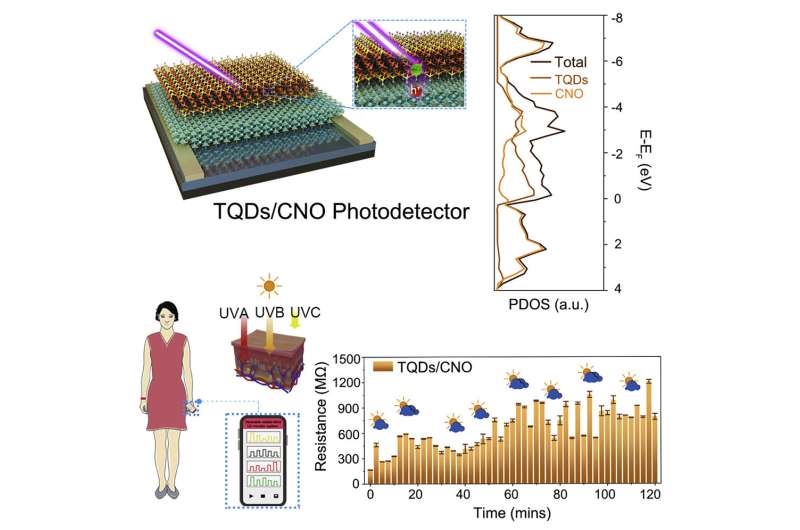
A team of researchers affiliated with multiple institutions in China has used perovskite and quantum dots to build an ultraviolet radiation measurement device. The group describes their experiment in Matter.
When people venture outdoors, they have no way of knowing the intensity of the ultraviolet light striking their body. This information is important because more intense UV light can lead to faster sunburn and potentially to skin cancer in later years. In this new effort, the researchers built a wearable device that can measure ultraviolet radiation in real-time and send the information to a smartphone.
To create their device, the researchers began with small amounts of the mineral perovskite, which has a long history of use in solar panels. They then added quantum dots, which are tiny, semiconducting particles used for a variety of applications such as enhancing colors on video screens.
Both materials are known to absorb UV radiation, which can then be converted to an electronic signal that can be used as a means of measuring the strength of ambient ultraviolet radiation. The team added more electronics to allow for sending the signal strength to a smartphone. The team then finished by creating a smartphone app able to read the signal and display charts and graphs on a smartphone.
The researchers also incorporated a neural network that uses UV data to predict near-term weather conditions. After training, the app was found to be approximately 80% accurate in making such predictions.
The researchers note that in addition to helping people prevent sunburn and skin cancer, the device could also be used by farmers working with smart greenhouses. It could be connected to a system that automatically turns UV lamps on and off depending on current weather conditions outside of the greenhouse.
More information:
Yiqiang Zheng et al, MXene quantum dots/perovskite heterostructure enabling highly specific ultraviolet detection for skin prevention, Matter (2022). DOI: 10.1016/j.matt.2022.11.020
Journal information:Matter

READ MORE
10 Helpful Tax Lessons for Kids
Um, Dad, why does the government want our money? © Randy Faris/Corbis Kids are the [...]
Researchers discover dual topological phases in an intrinsic monolayer crystal
QSH edge conduction at the CNP in monolayer TaIrTe4. Credit: Nature (2024). DOI: 10.1038/s41586-024-07211-8 Dual [...]
How to Prevent Soot Buildup in Your Car’s Engine
Exhaust billows out of a car tailpipe in San Francisco, Calif. David Paul Morris/Getty Images [...]
Novel metal-organic framework nanosheets developed for anticorrosive coating
The preparation of MOF nanosheets via traditional vs. surfactant-assisted methods. Credit: NIMTE The marine functional [...]
The Millennial’s Doctor Releases a Handbook on Bodies
Hamblin’s new book uses illustrations to help explain how the human body works—and sometimes doesn’t [...]
James Webb telescope finds origins of the biggest explosion since the Big Bang — revealing a new cosmological mystery
Seen in 2022, a gamma-ray burst nicknamed the BOAT is believed to be the brightest [...]
Toad vs. Frog: Differences in Anatomy, Habitat and More
Do you know how to tell whether this is a frog or a toad? Herman [...]
‘Nanobodies’ could hold clues to new COVID-19 therapies
Visualisation of SARS-CoV-2 virus with nanobodies (purple) attaching to the virus ‘spike’ protein. Credit: Dr [...]